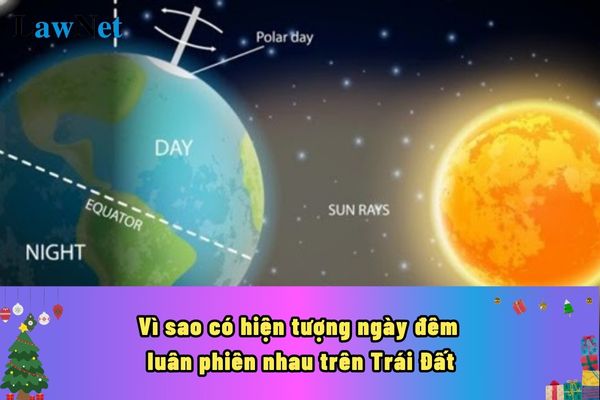Vietnam: Why does the phenomenon of day and night alternation occur on Earth? What is the grade at which students learn about the phenomenon of day and night alternation on Earth?
Why does the phenomenon of day and night alternation occur on Earth?
The phenomenon of day and night alternation on Earth occurs due to two main factors:
[1] The shape of the Earth: The Earth is spherical, so the Sun can illuminate only half of the Earth at any given time. The illuminated half experiences daytime, while the other half remains in nighttime.
[2] The Earth's rotation: The Earth is not stationary but rotates on its axis from west to east. This rotation causes every position on Earth to sequentially receive sunlight and then fall into darkness, creating the phenomenon of alternating day and night.
To visualize this, you can imagine the Earth as a spinning ball. When one part of the ball faces the Sun, that part lights up (daytime), while the rest is in shadow (nighttime). As the ball continues to spin, different parts sequentially get illuminated and fall into darkness.
*Why is this phenomenon important?
Life on Earth: The alternation of day and night is crucial for the existence and development of life on Earth. It creates biological cycles for organisms and affects the photosynthesis process of plants, the sleep-wake cycles of animals, and many other natural activities.
Time and calendar: This phenomenon also serves as the basis for humans to divide time into day and night, creating calendars to track time and events in life.
The alternation of day and night is a significant natural phenomenon, with profound implications for life on Earth and human existence. Some notable implications include:
For nature:
Biological cycles: The alternation of day and night creates a natural biological cycle for most organisms on Earth. Plants photoaggregate during the day, and animals sleep and are active according to their biological rhythms.
Climate regulation: The temperature change between day and night helps regulate the climate, creating diverse weather phenomena.
Water cycle: The temperature difference between day and night facilitates evaporation, condensation, and precipitation, maintaining the natural water cycle.
For humans:
Activity scheduling: Humans have relied on the alternation of day and night to create calendars, divide time into day and night, and organize daily life activities, work, and rest.
Perception of time: This phenomenon has influenced perceptions of time and the concepts of past, present, and future.
Culture and spirituality: The alternation of day and night has deeply impacted the culture and spirituality of many peoples. Many festivals and beliefs are tied to the transition between day and night.
Science: Understanding the alternation of day and night aids humans in research on the universe, time, and other astronomical phenomena.
*In summary:
The phenomenon of day and night alternation results from the Earth's spherical shape and its rotation. This phenomenon is extraordinarily significant for life on Earth and human existence.
*Note: The information regarding the cause of the phenomenon of day and night alternation on Earth is for reference only./.

Why does the phenomenon of day and night alternation occur on Earth? What is the grade at which students learn about the phenomenon of day and night alternation on Earth? (Image from the Internet)
In Vietnam, what is the grade at which students learn about the phenomenon of day and night alternation on Earth?
Under Section 5 of the General Education Program for History and Geography issued in conjunction with Circular 32/2018/TT-BGDDT:
Content:
- The position of Earth in the Solar System
- Shape and size of Earth
- Earth's movements and geographical consequences
Requirements:
- Identify the position of Earth in the Solar System.
- Describe the shape and size of Earth.
- Describe Earth's movements (rotation and orbit around the Sun).
- Determine direction based on observing natural phenomena or using a compass.
- Recognize local/regional time, and compare the time of two locations on Earth.
- Explain the phenomenon of day and night alternation and describe the deflection of an object's movement along meridians.
- Explain the phenomenon of seasonal variation in day length.
Thus, students will learn about the phenomenon of day and night alternation on Earth in 6th grade.
Are History and Geography mandatory subjects in Vietnam?
According to Section 1 of the General Education Program for History and Geography issued with Circular 32/2018/TT-BGDDT regulating the characteristics of History and Geography:
I. CHARACTERISTICS OF THE SUBJECT
History and Geography at the lower secondary school level are subjects that play an important role in forming and developing core qualities, general capacities, and scientific capacities characterized by historical and geographical competencies; laying the groundwork for students to pursue high school, vocational education, or participate in workforce life, becoming useful citizens.
History and Geography are mandatory subjects taught from grade 6 to grade 9. The subject comprises educational content in history, geography, and some interdisciplinary topics, while also integrating knowledge at a simple level about economics, culture, science, religion,... The historical and geographical knowledge streams are connected to illuminate and support each other. Additionally, the subject includes several interdisciplinary topics, such as the protection of sovereignty, legal rights, and interests of Vietnam in the East Sea; urbanization - history and present; civilizations of the Red River and Mekong River deltas; major geographical discoveries,...
Thus, according to the above regulations, History and Geography are mandatory subjects in Vietnam.

